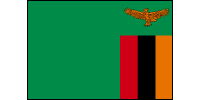| Country (long form) |
Republic of Zambia |
| Capital |
Lusaka |
| Total Area |
290,585.89 sq mi
752,614.00 sq km
(slightly larger than Texas) |
| Population |
9,770,199 (July 2001 est.)
note: estimates for this country explicitly take into account the effects of excess mortality due to AIDS; this can result in lower life expectancy, higher infant mortality and death rates, lower population and growth rates, and changes in the distribution of population by age and sex than would otherwise be expected |
| Estimated Population in 2050 |
20,288,861 |
| Languages |
English (official), major vernaculars - Bemba, Kaonda, Lozi, Lunda, Luvale, Nyanja, Tonga, and about 70 other indigenous languages |
| Literacy |
78.2% total, 85.6% male, 71.3% female (1995 est.) |
| Religions |
Christian 50%-75%, Muslim and Hindu 24%-49%, indigenous beliefs 1% |
| Life Expectancy |
37.06 male, 37.53 female (2001 est.) |
| Government Type |
republic |
| Currency |
1 Zambian kwacha (ZK) = 100 ngwee |
| GDP (per capita) |
$880 (2000 est.) |
| Industry |
copper mining and processing, construction, foodstuffs, beverages, chemicals, textiles, fertilizer |
| Agriculture |
corn, sorghum, rice, peanuts, sunflower seed, vegetables, flowers, tobacco, cotton, sugarcane, cassava (tapioca); cattle, goats, pigs, poultry, milk, eggs, hides; coffee |
| Arable Land |
7% |
| Natural Resources |
copper, cobalt, zinc, lead, coal, emeralds, gold, silver, uranium, hydropower |
|


|